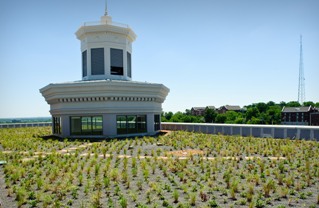 With the official opening of the new health science building next week, the installation of a green roof on 90,000-square-foot facility has recently been completed. The only large extensive green roof on an educational facility in Nashville, the green roof serves several purposes including a reduction in the “heat island effect,” which refers to the trend of generally higher temperatures in urban areas as opposed to more suburban areas. The green roof lowers air temperatures which helps reduce that effect. Green roofs also provide natural habitats for wildlife (birds, insects, etc.) and reduce pollution by holding pollutants rather than washing into groundwater, sewer or drainage systems. In addition, the green roof can retain some rainwater for irrigation and can reduce the heating/cooling costs by providing lower temperatures around air intake systems.
With the official opening of the new health science building next week, the installation of a green roof on 90,000-square-foot facility has recently been completed. The only large extensive green roof on an educational facility in Nashville, the green roof serves several purposes including a reduction in the “heat island effect,” which refers to the trend of generally higher temperatures in urban areas as opposed to more suburban areas. The green roof lowers air temperatures which helps reduce that effect. Green roofs also provide natural habitats for wildlife (birds, insects, etc.) and reduce pollution by holding pollutants rather than washing into groundwater, sewer or drainage systems. In addition, the green roof can retain some rainwater for irrigation and can reduce the heating/cooling costs by providing lower temperatures around air intake systems.
Local firm Hodgson & Douglas provided the landscape architectural design for the green roof. Landscape architect Joe Hodgson said, “The green roof was developed using planting that might commonly be found in a middle Tennessee cedar glade. All the plants are native and easily adaptive to the type of soil found on an extensive green roof.”
The plantings on the green roof are in four inches of soil and gravel. They are low-growing, low water-usage plants, with 85 percent being flowering and colorful. One of the plantings is the Tennessee Coneflower, which once was an endangered seed planting. Other planted species include Elfin Gold Coreopsis, Beardtongue, Prairie Phlox, Prairie Drop Seed, Stoke’s Aster and Little Bluestem.
The green roof is only one aspect of the new structure’s environmentally sustainable initiatives. In addition, the building’s four-level underground parking garage reduces the structural footprint, saving four acres of land that would have been lost to surface parking. The building’s total footprint, including the garage, is less than an acre. Another significant “green” feature is the 20,000 gallon water storage tank, which will have the ability to capture excess ground and storm water that would otherwise be pumped into the storm system. The collected water will be recycled and used to irrigate the campus.
David W. Minnigan, AIA, LEED® AP, a principal of the architectural firm ESa, said, “Obviously, it’s a thrill for our firm to be part of all this. Belmont’s desire to be sustainable and to look at ways it can be on the leading edge is just who they are. It’s a pleasure to work with the University and to see how involved they are in promoting sustainable initiatives and high performance buildings.”
